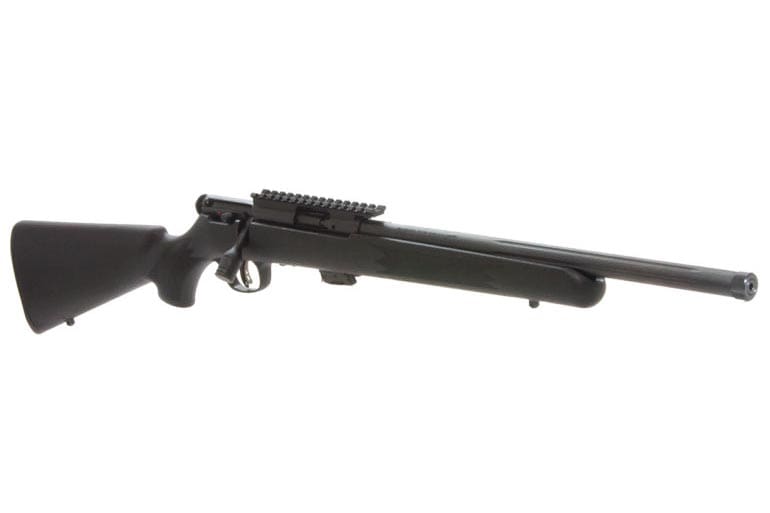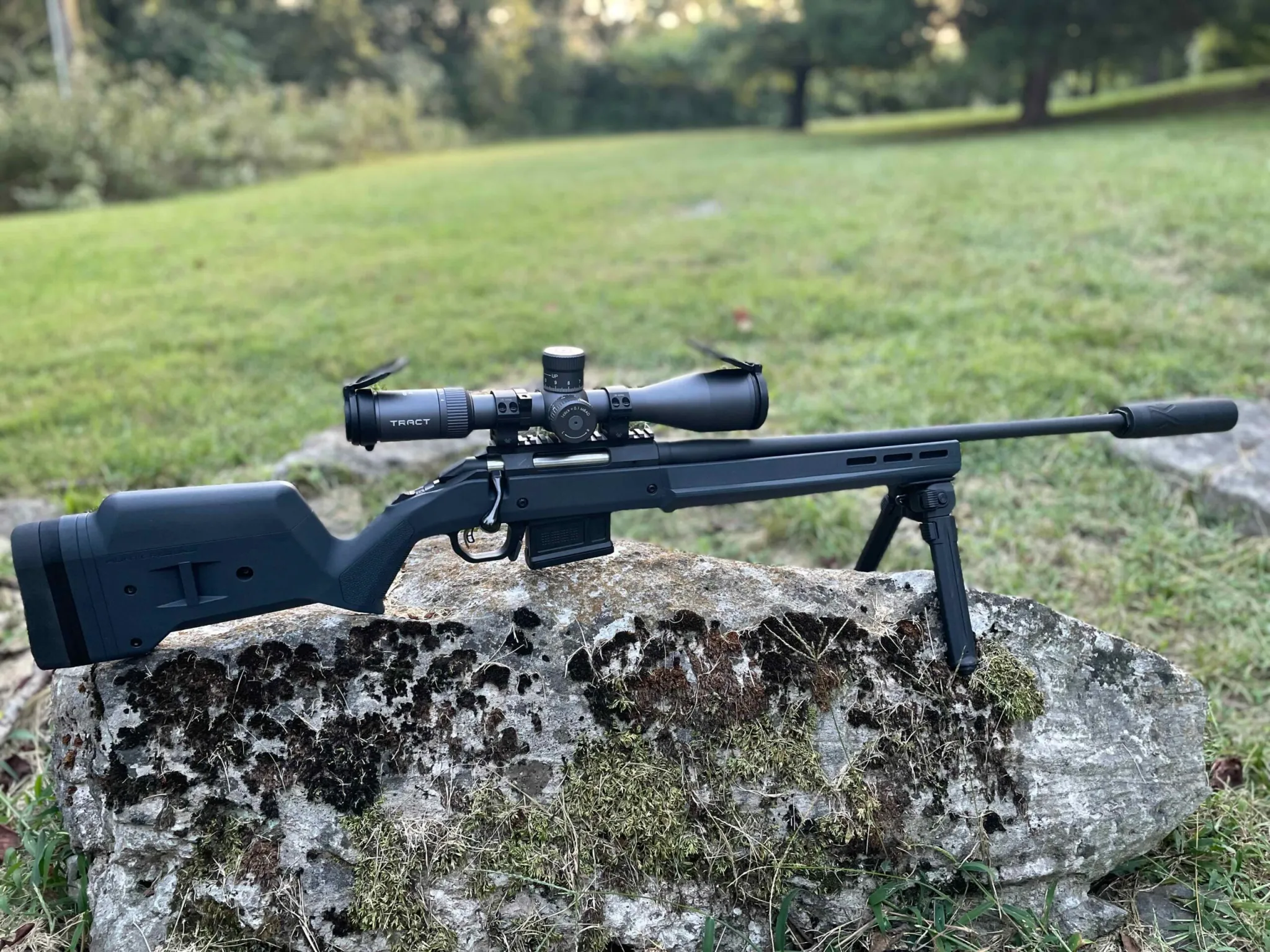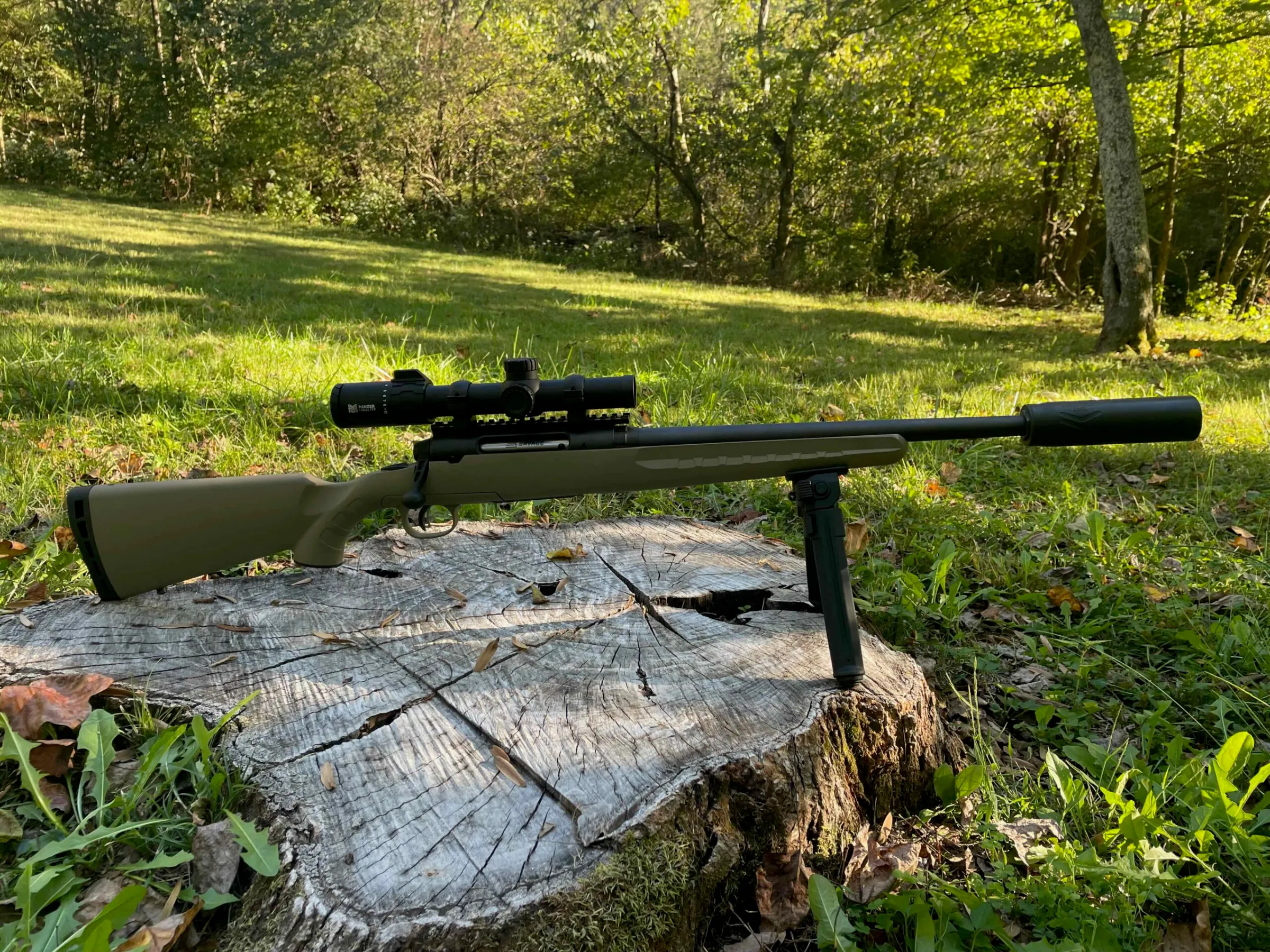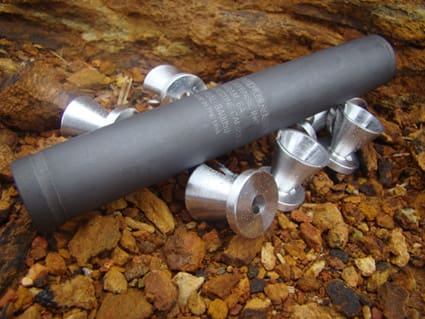
Shooters are seeing a lot of factory-threaded barrels that accept sound suppressors and other muzzle devices, and rimfire rifles, such as the Savage MKII FV-SR Threaded Barrel 22LR, are part of this new supply. In the past, I’ve thought of suppressors as add-ons to my GLOCK 9mm pistol or a Remington .45 ACP 1911, but I’ve learned muzzle mufflers can improve my comfort behind 22LR rifles as well.
The American-made Savage MKII bolt-action repeater came in a box with a lock and manual. The manual covered the Mark II’s as well as Savage’s Mark I, Rascal, Model 93, B.Mag, and Model 300, Model 305, and Model 310 rifles. The FV-SR looked stubby with a 16.5-inch carbon-steel fluted barrel. Rate of twist was a standard 1:16 inches for .22 Long Rifle.
The diameter of the barrel at the muzzle was 0.870 inch, which suggests the free-floating barrel’s straight contour might make the rifle heavy. But the unloaded weight was just 6 pounds. Also, it wasn’t overly muzzle heavy, with the balance point of the scoped rifle occurring right under the magwell. With a scope and full of ammo, the Savage weighed 7.25 pounds. Its short overall length of 34.75 inches would make it handy to handle going in and out of a vehicle.
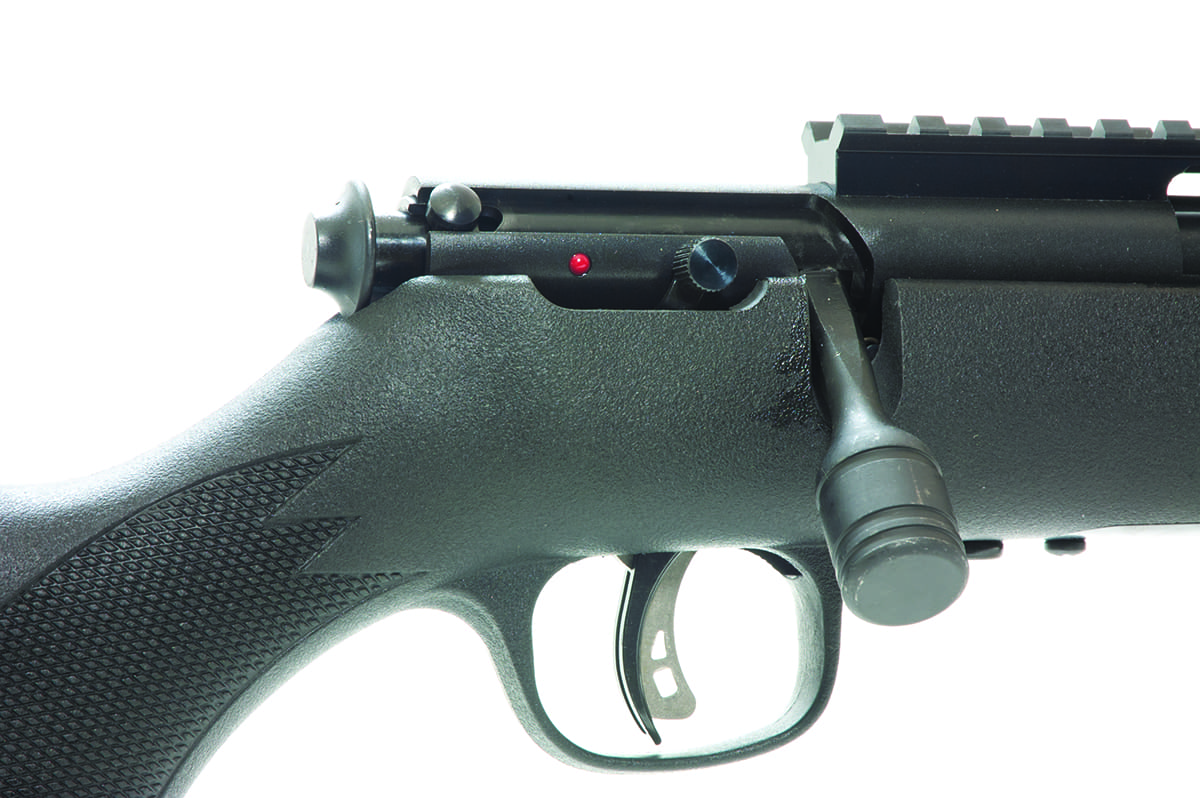
The Savage came with an installed Picatinny scope rail, so it was easy to screw on Weaver’s Six Hole Tactical Rings and install a Nikon M-223 series 3-12x42mm (16305) scope. That glass is equipped with a side-focus turret for parallax correction and a one-piece 1-inch main tube that is nitrogen-filled and O-ring-sealed.
Between shots, I could stay on the stock and adjust the scope because the Nikon has target-style knobs with tactile clicks. That makes it easy to dial in wind adjustments on the Nikon, but I rarely needed more than a click left or right of zero because I had 5- to 7-o’clock wind for most of my shooting.
The bolt-action rifle had a matte-black-finish synthetic stock with a round sporter forend, which rolled on the bags. The straight comb needed more height to allow my face to anchor on the stock, but that will vary by shooter.
The buttstock had a 13.5-inch length of pull. There was a sling-swivel stud at the front to attach a bipod or sling. The neutral butt dimensions, no cast-on or cast-off, worked for both righties and lefties (handedness, not politics). This rifle didn’t have an AccuStock bedding system, but the barrel free-floated nonetheless. Molded-in checkered panels on the wrist and forend offered some texture for a better grip on the stock.
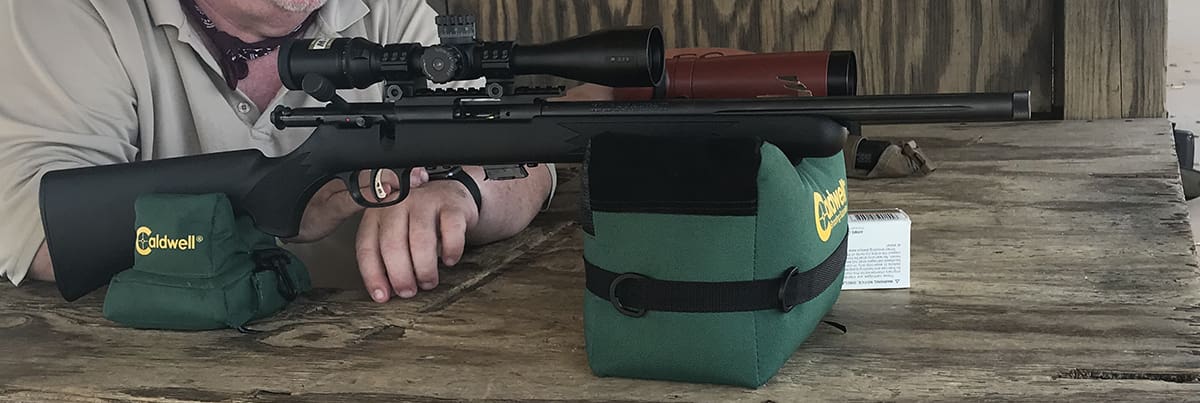
I found the thread protector was easy to remove and install. I liked the big bolt handle because it provided a lot of smooth riding surface to push and pull the action closed and open without grasping the knob itself. The Savage came with one 5-round-capacity single-stack detachable-box magazine with a steel body. I had no misfeeds, and the magazine was easy to seat. I also had no failures to fire or extract. Ejected brass landed near or far at about 4 o’clock, depending on how hard I worked the bolt.
One of the nicer trends in non-competition smallbore rifles is the appearance of adjustable triggers. It wasn’t too many years ago that a small-game rifle like this Savage would have come with a creepy 7-pound trigger. This one came with an adjustable AccuTrigger, and I was happy to tune it.
- To adjust the AccuTrigger in the Mark II, make sure the firearm is unloaded and the bolt is open before removing the stock and messing with the trigger. Then remove the stock.
- Insert the AccuTrigger’s supplied tool into the bottom of the trigger return spring to engage the spring-tail with the slot on the tool.
- Turn the trigger return spring with the trigger adjustment tool.
- To adjust for a heavier pull, turn the tool clockwise. The maximum trigger pull is at the point where the spring clicks when rotated.
- Turning the tool counter-clockwise moved me toward a minimum trigger pull. I was happy when I got the pull to 2.4 pounds, and I dropped the rifle on its butt at different angles to ensure that the sear didn’t release.
For bench-accuracy shooting at 50 yards, I fired the rifle off of Caldwell DeadShot shooting bags. Accuracy is the average group size for five five-shot groups, measured center-to-center of the widest-apart bullet holes in each group, then rounded to the nearest tenth of an inch. Suppressed data was collected with a SilencerCo Osprey 45 ($756 at SilencerShop.com) directly after I shot the unsuppressed data for each round.
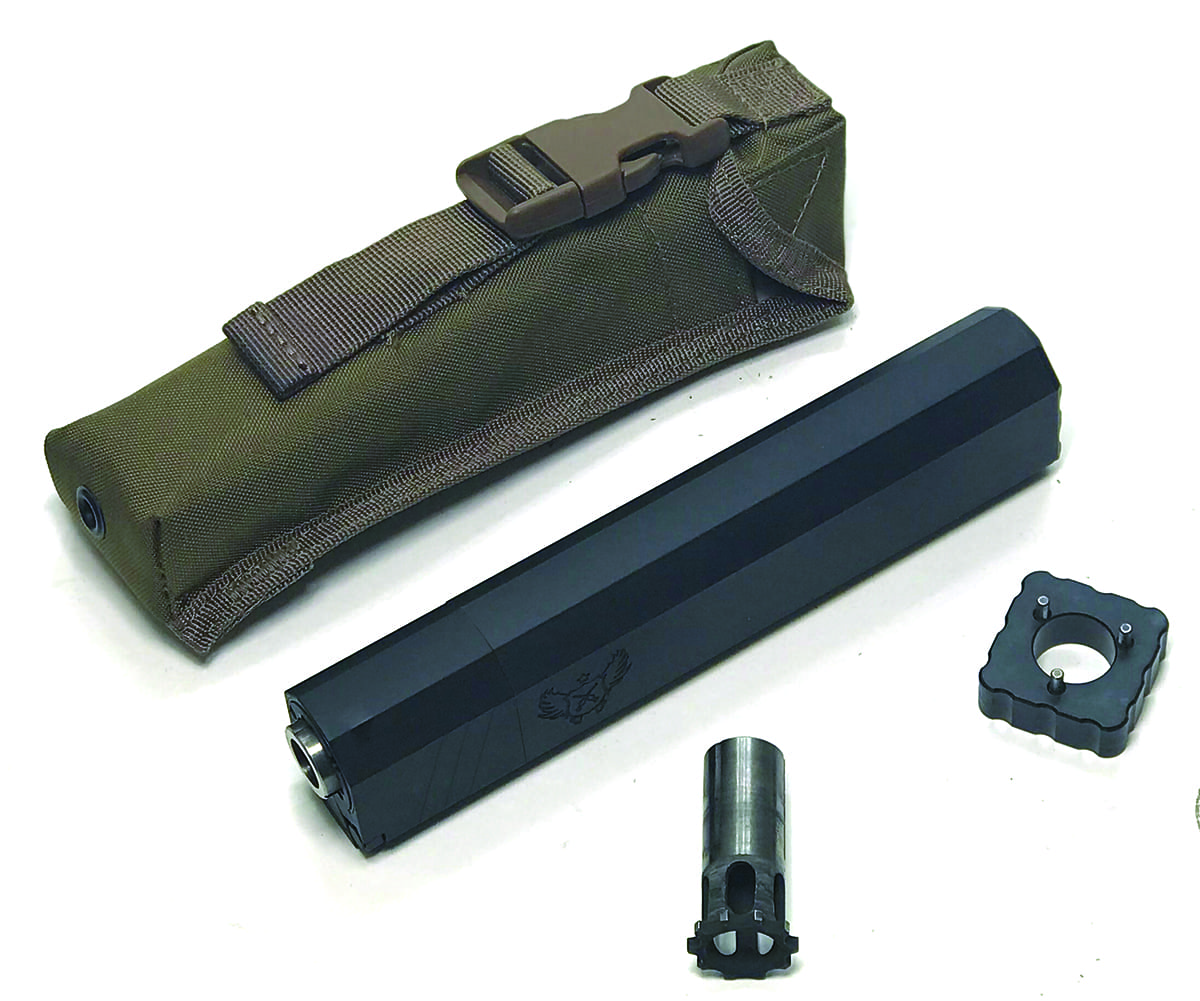
The SilencerCo Osprey 45 is an eccentric monocore baffle design with a black-oxide aluminum shell and stainless-steel internals. The Osprey 45 weighs 11.1 ounces and measures 8 inches in length. To fit the Savage 22 rifle, I used a 9mm Osprey piston, $71, also from Silencer Shop in Austin.
Suppressors are generally manufactured with different thread dimensions to make it harder to accidentally fit a too-small suppressor onto a too-large-caliber firearm. I would be giving up some suppression by using a larger-dimension exit hole than necessary, but the Osprey wasn’t out of scale for use on the rifle. Also, I didn’t intend to shoot a lot of rimfire rounds with the Osprey because the can isn’t user serviceable, and smallbore rounds would get it dirty pretty fast.
The Osprey comes with a tool to remove the piston and a user manual. To install the piston in the end attaching to the muzzle, the user slides the piston (a stainless cylinder with spokes on one end) into a spring inside a threaded adapter, which then screws into the suppressor body.
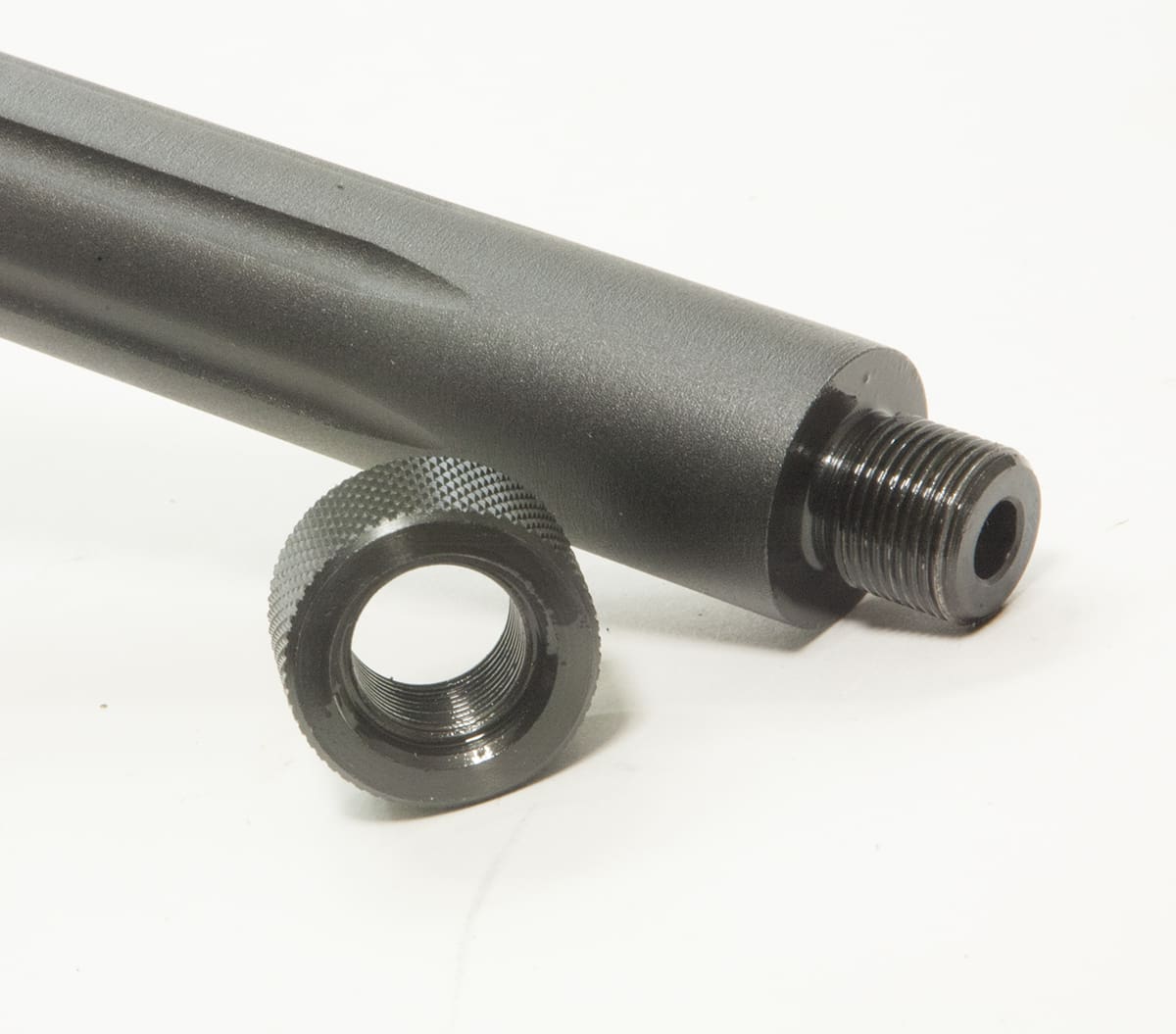
Installation on the rifle was simple: With the magazine out of the rifle and the bolt out of the action, I screwed off the thread protector, then tilted the suppressor-ready muzzle upward and started the Osprey onto the provided muzzle threads.
I removed the bolt and magazine for safety because my front hand could be covered by the muzzle when removing the thread protector and installing the can. Also, with the bolt out of the gun, I could look down the muzzle to ensure the suppressor wasn’t impinging on the bullet path.
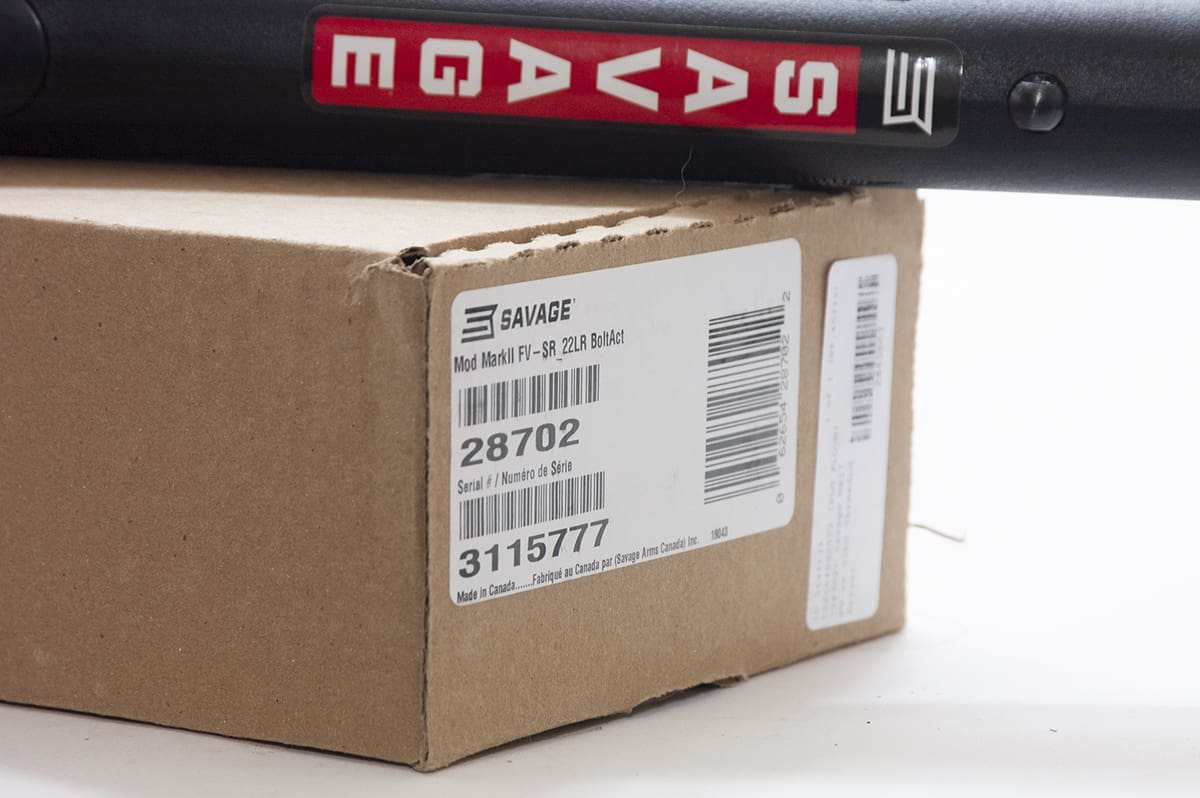
My 22 Long Rifle ammo samples included Armscor 36-grain high-velocity ammo, Eley Subsonic 38-grain lead hollow points, and Winchester WINS22LRT M-22 40-grain black copper-plated lead round nose bullets. The Eley’s velocities came in at 1014 fps and 1025 fps unsuppressed/suppressed in the Savage. In the middle were the Winchester M-22’s speeds at 1172 fps unsuppressed and 1179 fps suppressed.
The Armscor’s velocities were 1238 fps/1261 fps unsuppressed/suppressed in the Savage Mark II. To collect chronograph and accuracy data, I set up at American Shooting Centers in Houston (AMShootCenters.com). I recorded velocities using a Competitive Edge Dynamics M2 Chronograph ($219 at Brownells.com, Part No. 399-000-012WB) with the first screen set 10 feet from the muzzle. Velocities were recorded with an air temperature of 90 degrees and 90% humidity, with 10-mph mostly 6 o’clock winds.
With the Osprey installed, I found the rifle’s report to be very quiet with the supersonic rounds, and I really couldn’t hear the subsonic rounds with double hearing protection (plugs and muffs) on. (Other shooters were on the range.) The gun would move slightly, and that was a better cue that it had fired than any sound.
The Savage shot its best groups with the Eley subsonic hollowpoints, 0.7 inches unsuppressed and 0.5 inches suppressed. With the Armscor 36-grain High-Velocity Hollow Points, the Savage fired 1.1-inch average groups unsuppressed and 1.0-inch groups suppressed. The heavier but still supersonic Winchester M-22 40-grain lead round nose rounds shot unsuppressed average groups of 1.0 inches and suppressed average groups of 0.9 inches.
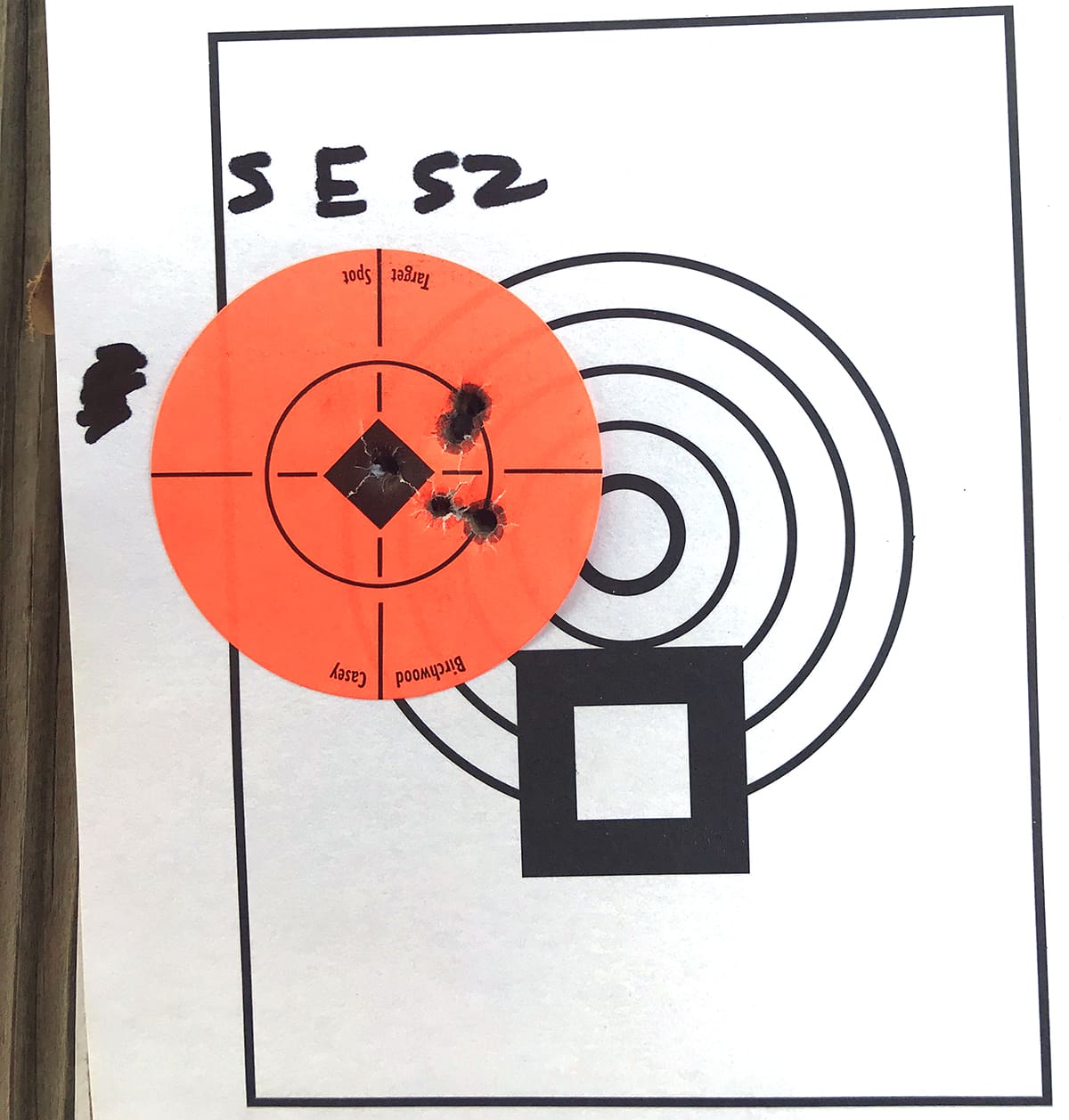
When kneeling and standing, I could run the 60-degree bolt throw comfortably without having to take my cheek off the stock. The big bolt handle aided this process as well. However, in these other positions, the high scope position atop the rail and rings only allowed a cheek-weld on the gun with the side of my jawbone.

I would have liked a comb-height adjustment pad like the D&E Cheekeeze stick-on pad ($40 from Brownells, Part No. 946-101-925WB) to rest my face on.
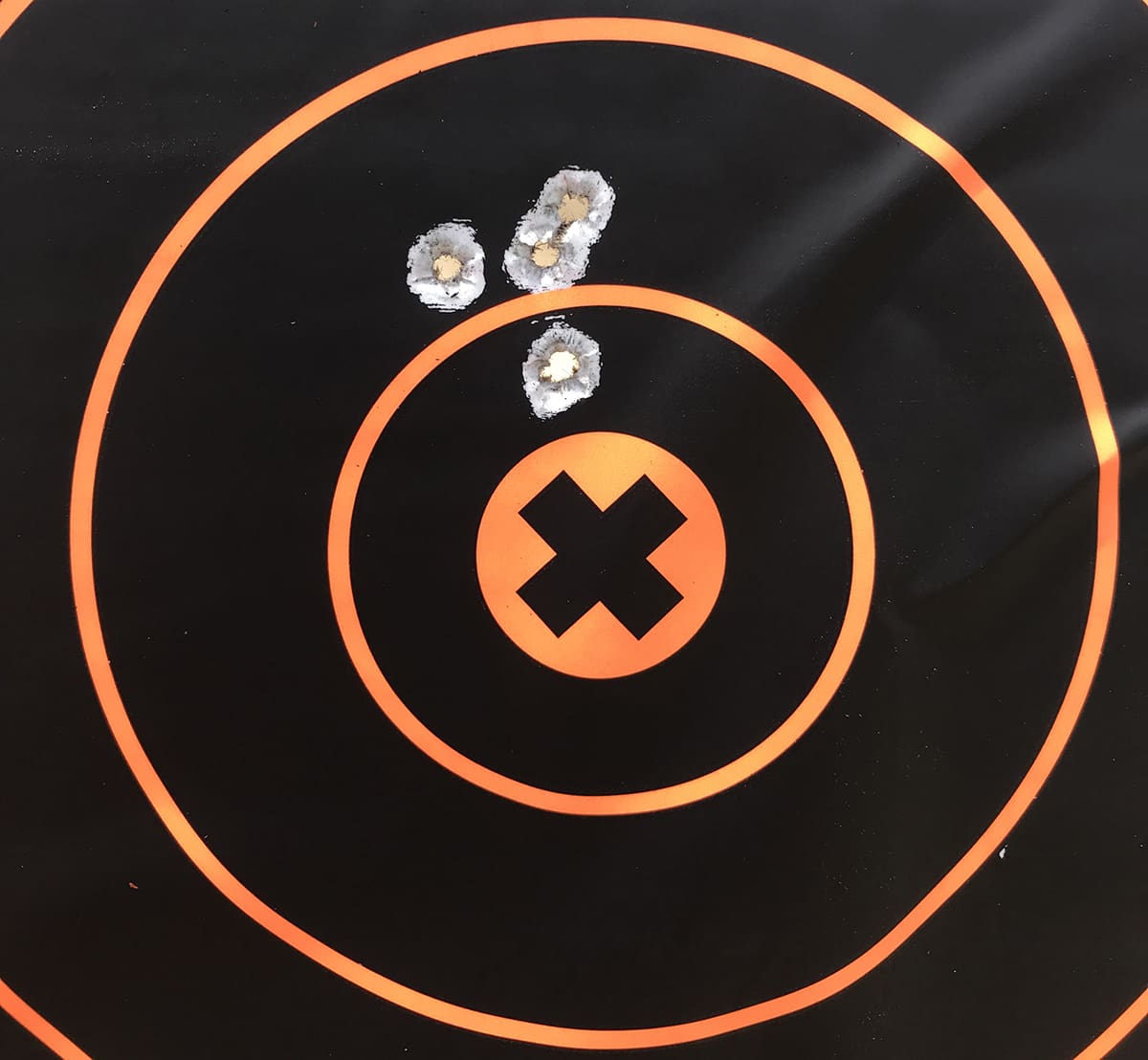
There was a thin plastic buttpad on the Savage. I would have preferred a rubber buttpad to stick better on the shoulder, but many shooters wouldn’t like that. The safety on the Savage Mark II FV-SR is on safe when the button sits fully rearward toward the shooter and a red dot on the right rear of the receiver is covered. This blocks the trigger but does not prevent the bolt from being opened.
In the fire position, the safety button is pushed toward the target, exposing the red dot on the receiver. Everything worked perfectly. Removing the bolt for cleaning, bore-sighting, or safety is simple. With no ammunition in the chamber and the bolt loosely open, I pulled the trigger fully rearward and held it in that position, then slide the bolt out the back of the receiver.
To insert the bolt, with an empty chamber and no magazine in the rifle, I lined up the bolt in the action and pulled trigger rearward, depressing the catch in the action that blocks the bolt. The bolt slid right in.
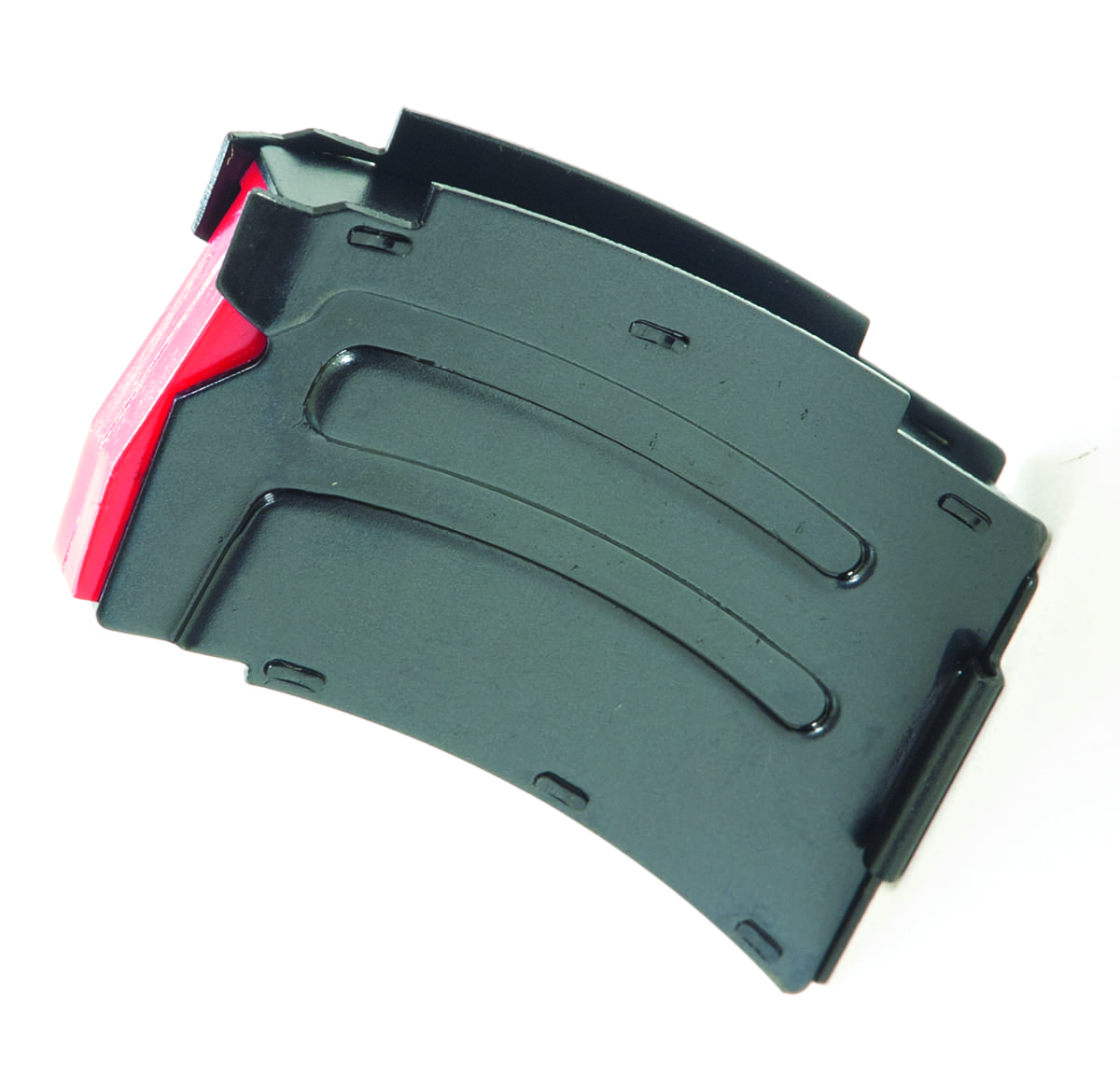
I liked the feel of the detachable magazine fit and lock, and the steel body of the magazine was rigid. I liked the bolt handle, and the AccuTrigger was excellent. It has a short overall length, which makes it suitable for use with a silencer. The affordability of this Savage rifle makes it a candidate for your wish list.
Other rifles TTAG has looked at in this arena include the CZ 455 Varmint Tacticool Suppressor-Ready Rifle and the Primary Weapons Systems T3 Summit Rifle.
Specifications: Savage Arms MKII FV-SR Threaded Barrel 22 LR
Action Type: Bolt action
Cartridge: 22 Long Rifle
Overall Length: 34.75 in.
Weight: 6.0 lbs.
Barrel Length: 16.5 in.
Barrel Muzzle Thread Pattern: 1/2×28
Magazine: 1 x 5-round
Finish: Matte Black
Front Sight: None
Rear Sight: None
Optics Ready: Yes, Picatinny rail installed
Stock Material: Matte black synthetic stock
MSRP: $295 ($234.99 at Brownells)
Ratings (out of five stars):
Style and Appearance * * *
Utilitarian looks. Stubby lines. Looking good isn’t its role.
Ergonomics * * * *
Too much drop in the buttstock for some shooting positions. Pretty good balance for a heavyweight barrel.
Accuracy * * * * *
The FV-SR shoots well with ammo it likes, like any other rimfire. You have to find the best ammo by lot-testing. Hopefully, you’ll find something that shoots well both suppressed and unsuppressed. I liked the Eley Subsonic in this role.
Reliability * * * * *
Bolt gun. Positive and dependable extraction and ejection. Feeding was accurate, with no bullet marring.
Overall Rating * * * * 1/2
A lot of gun for the money. The adjustable trigger is a plus. The free-floated barrel is a plus. The easy connectivity for a suppressor is a plus. Having a Pic rail already mounted on the receiver is a plus. I’d prefer this unit over a similar heavy-barrel choice that isn’t threaded at the muzzle.

